Management and Leadership: Roles, Theories, and Starbucks Case Study
VerifiedAdded on 2021/02/20
|20
|4721
|349
Report
AI Summary
This report delves into the concepts of leadership and management, using Starbucks as a case study to illustrate key principles. It begins by differentiating between the roles of a leader and the functions of a manager, highlighting their distinct responsibilities and approaches within an organization. The report then explores various leadership theories, including situational, systems, and contingency theories, and applies them to the context of Starbucks, examining how these theories influence the company's operations and employee management. Furthermore, the report demonstrates an appreciation for the roles leaders and managers play in the operations function, touching on concepts such as Total Quality Management (TQM), Just-In-Time (JIT), and continuous improvement. Finally, the report analyzes the relationship between leadership and management within a contemporary business environment, considering the impact of political, economic, socio-cultural, technological, environmental, and legal factors on Starbucks' operations. The report also compares the roles of managers and leaders within the company, providing insights into their respective responsibilities.
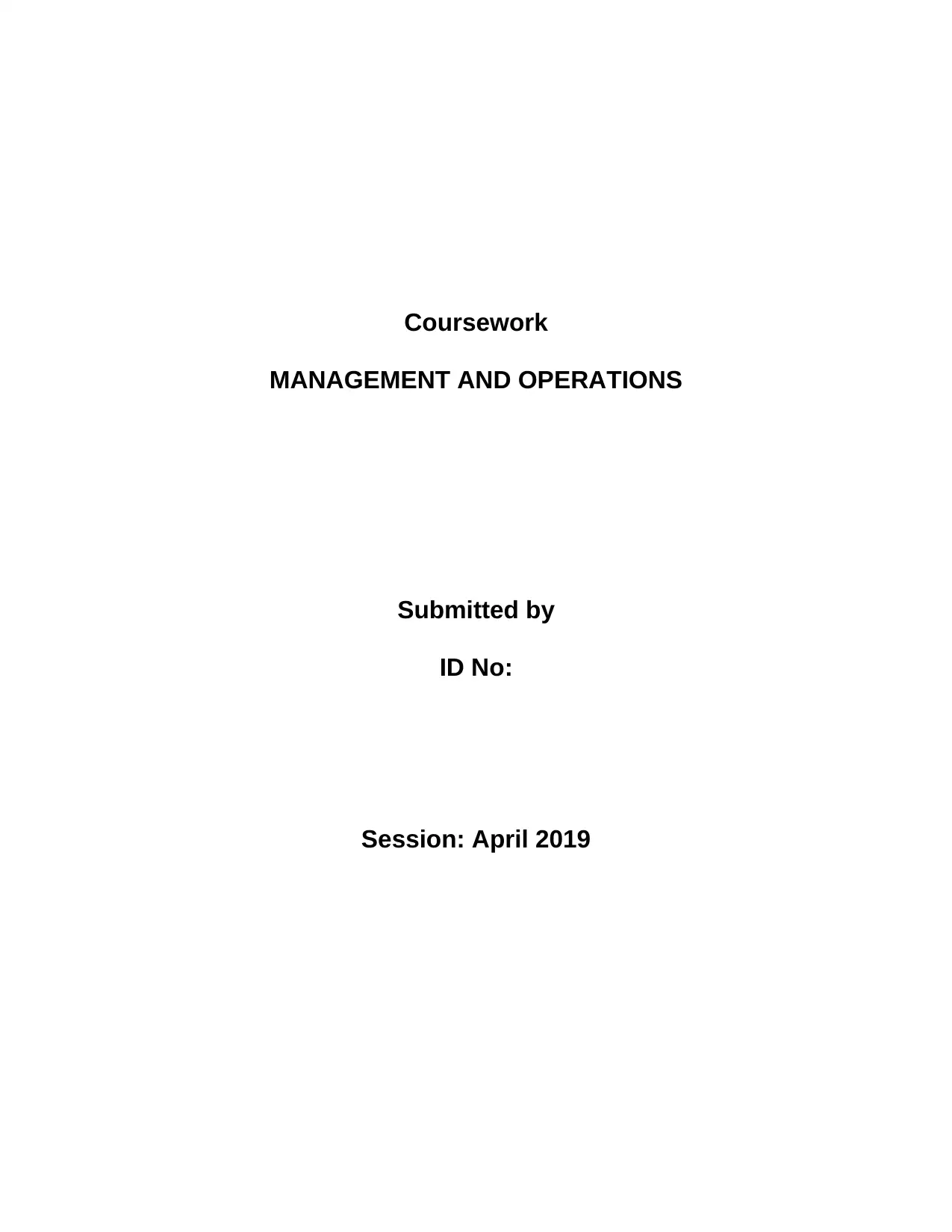
Coursework
MANAGEMENT AND OPERATIONS
Submitted by
ID No:
Session: April 2019
MANAGEMENT AND OPERATIONS
Submitted by
ID No:
Session: April 2019
Paraphrase This Document
Need a fresh take? Get an instant paraphrase of this document with our AI Paraphraser
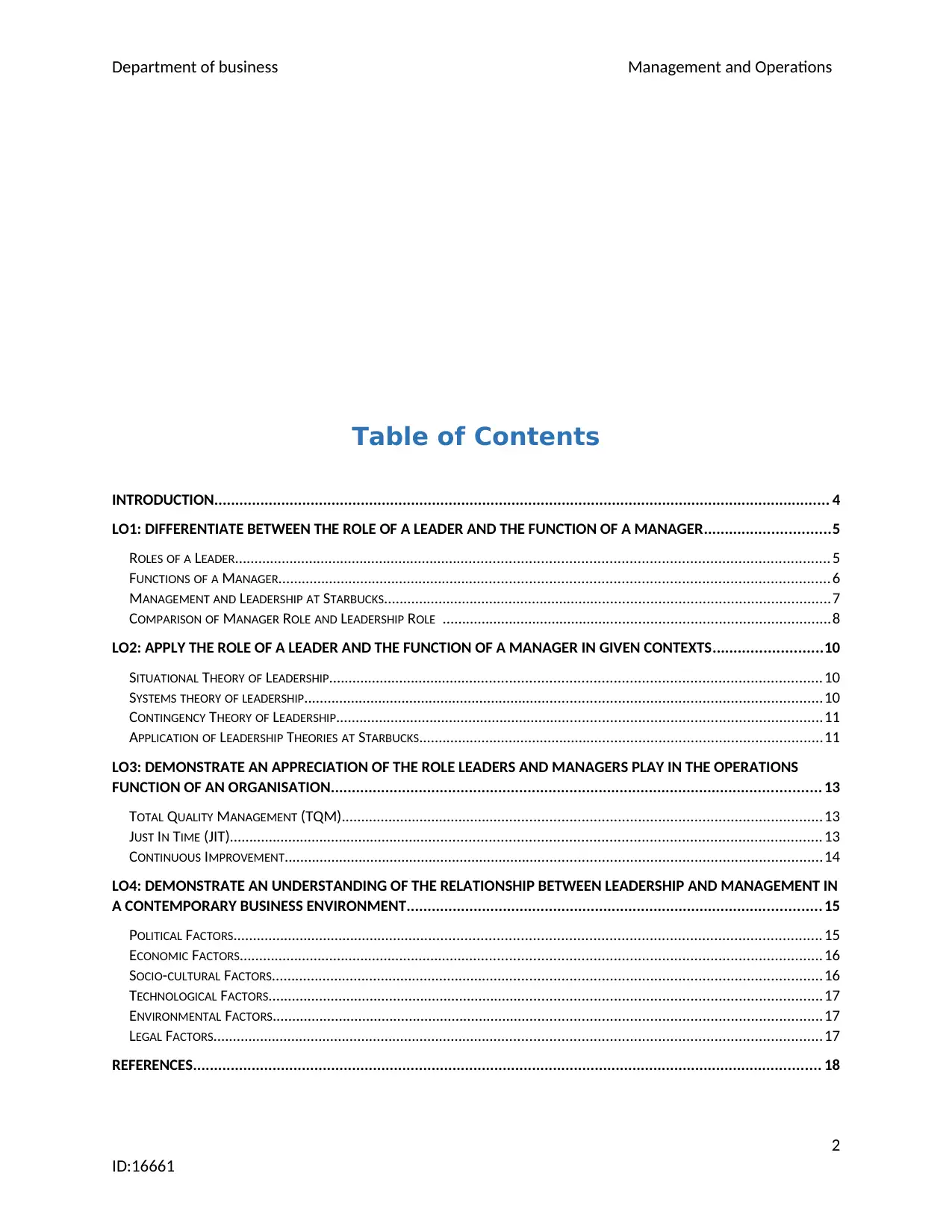
Department of business Management and Operations
Table of Contents
INTRODUCTION................................................................................................................................................... 4
LO1: DIFFERENTIATE BETWEEN THE ROLE OF A LEADER AND THE FUNCTION OF A MANAGER..............................5
ROLES OF A LEADER......................................................................................................................................................5
FUNCTIONS OF A MANAGER...........................................................................................................................................6
MANAGEMENT AND LEADERSHIP AT STARBUCKS.................................................................................................................7
COMPARISON OF MANAGER ROLE AND LEADERSHIP ROLE ..................................................................................................8
LO2: APPLY THE ROLE OF A LEADER AND THE FUNCTION OF A MANAGER IN GIVEN CONTEXTS..........................10
SITUATIONAL THEORY OF LEADERSHIP............................................................................................................................10
SYSTEMS THEORY OF LEADERSHIP...................................................................................................................................10
CONTINGENCY THEORY OF LEADERSHIP...........................................................................................................................11
APPLICATION OF LEADERSHIP THEORIES AT STARBUCKS......................................................................................................11
LO3: DEMONSTRATE AN APPRECIATION OF THE ROLE LEADERS AND MANAGERS PLAY IN THE OPERATIONS
FUNCTION OF AN ORGANISATION..................................................................................................................... 13
TOTAL QUALITY MANAGEMENT (TQM).........................................................................................................................13
JUST IN TIME (JIT)..................................................................................................................................................... 13
CONTINUOUS IMPROVEMENT........................................................................................................................................14
LO4: DEMONSTRATE AN UNDERSTANDING OF THE RELATIONSHIP BETWEEN LEADERSHIP AND MANAGEMENT IN
A CONTEMPORARY BUSINESS ENVIRONMENT................................................................................................... 15
POLITICAL FACTORS.................................................................................................................................................... 15
ECONOMIC FACTORS...................................................................................................................................................16
SOCIO-CULTURAL FACTORS...........................................................................................................................................16
TECHNOLOGICAL FACTORS............................................................................................................................................17
ENVIRONMENTAL FACTORS...........................................................................................................................................17
LEGAL FACTORS..........................................................................................................................................................17
REFERENCES...................................................................................................................................................... 18
2
ID:16661
Table of Contents
INTRODUCTION................................................................................................................................................... 4
LO1: DIFFERENTIATE BETWEEN THE ROLE OF A LEADER AND THE FUNCTION OF A MANAGER..............................5
ROLES OF A LEADER......................................................................................................................................................5
FUNCTIONS OF A MANAGER...........................................................................................................................................6
MANAGEMENT AND LEADERSHIP AT STARBUCKS.................................................................................................................7
COMPARISON OF MANAGER ROLE AND LEADERSHIP ROLE ..................................................................................................8
LO2: APPLY THE ROLE OF A LEADER AND THE FUNCTION OF A MANAGER IN GIVEN CONTEXTS..........................10
SITUATIONAL THEORY OF LEADERSHIP............................................................................................................................10
SYSTEMS THEORY OF LEADERSHIP...................................................................................................................................10
CONTINGENCY THEORY OF LEADERSHIP...........................................................................................................................11
APPLICATION OF LEADERSHIP THEORIES AT STARBUCKS......................................................................................................11
LO3: DEMONSTRATE AN APPRECIATION OF THE ROLE LEADERS AND MANAGERS PLAY IN THE OPERATIONS
FUNCTION OF AN ORGANISATION..................................................................................................................... 13
TOTAL QUALITY MANAGEMENT (TQM).........................................................................................................................13
JUST IN TIME (JIT)..................................................................................................................................................... 13
CONTINUOUS IMPROVEMENT........................................................................................................................................14
LO4: DEMONSTRATE AN UNDERSTANDING OF THE RELATIONSHIP BETWEEN LEADERSHIP AND MANAGEMENT IN
A CONTEMPORARY BUSINESS ENVIRONMENT................................................................................................... 15
POLITICAL FACTORS.................................................................................................................................................... 15
ECONOMIC FACTORS...................................................................................................................................................16
SOCIO-CULTURAL FACTORS...........................................................................................................................................16
TECHNOLOGICAL FACTORS............................................................................................................................................17
ENVIRONMENTAL FACTORS...........................................................................................................................................17
LEGAL FACTORS..........................................................................................................................................................17
REFERENCES...................................................................................................................................................... 18
2
ID:16661
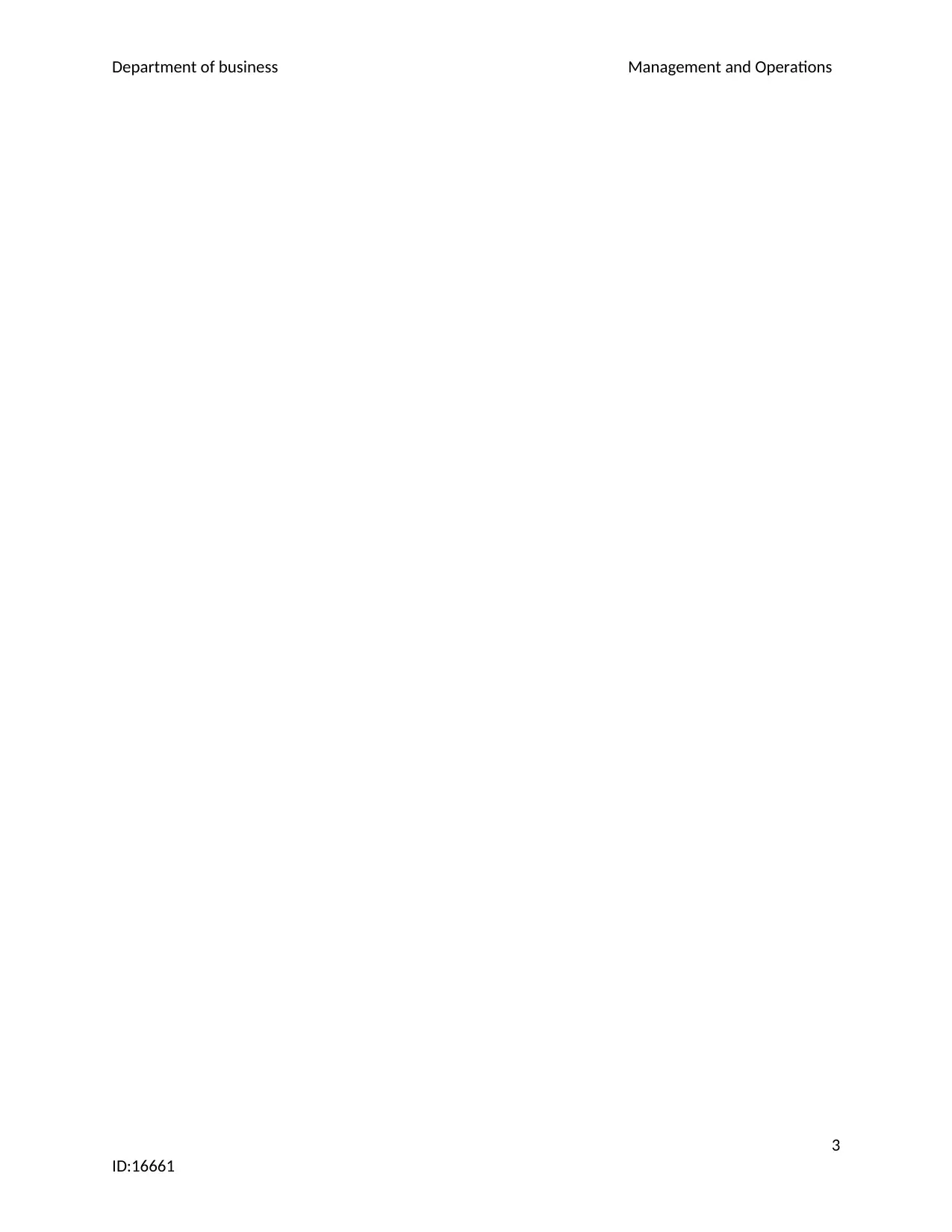
Department of business Management and Operations
3
ID:16661
3
ID:16661
⊘ This is a preview!⊘
Do you want full access?
Subscribe today to unlock all pages.

Trusted by 1+ million students worldwide
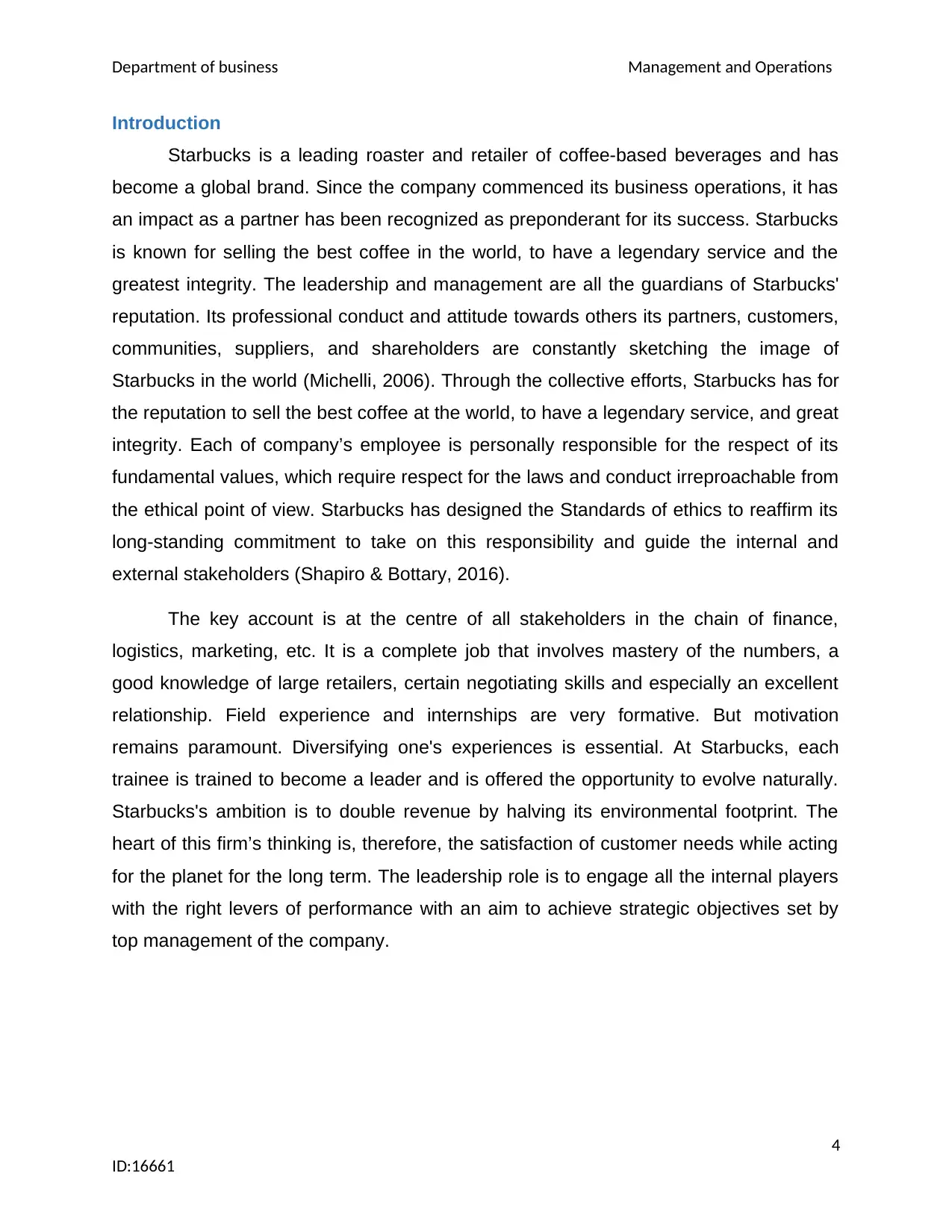
Department of business Management and Operations
Introduction
Starbucks is a leading roaster and retailer of coffee-based beverages and has
become a global brand. Since the company commenced its business operations, it has
an impact as a partner has been recognized as preponderant for its success. Starbucks
is known for selling the best coffee in the world, to have a legendary service and the
greatest integrity. The leadership and management are all the guardians of Starbucks'
reputation. Its professional conduct and attitude towards others its partners, customers,
communities, suppliers, and shareholders are constantly sketching the image of
Starbucks in the world (Michelli, 2006). Through the collective efforts, Starbucks has for
the reputation to sell the best coffee at the world, to have a legendary service, and great
integrity. Each of company’s employee is personally responsible for the respect of its
fundamental values, which require respect for the laws and conduct irreproachable from
the ethical point of view. Starbucks has designed the Standards of ethics to reaffirm its
long-standing commitment to take on this responsibility and guide the internal and
external stakeholders (Shapiro & Bottary, 2016).
The key account is at the centre of all stakeholders in the chain of finance,
logistics, marketing, etc. It is a complete job that involves mastery of the numbers, a
good knowledge of large retailers, certain negotiating skills and especially an excellent
relationship. Field experience and internships are very formative. But motivation
remains paramount. Diversifying one's experiences is essential. At Starbucks, each
trainee is trained to become a leader and is offered the opportunity to evolve naturally.
Starbucks's ambition is to double revenue by halving its environmental footprint. The
heart of this firm’s thinking is, therefore, the satisfaction of customer needs while acting
for the planet for the long term. The leadership role is to engage all the internal players
with the right levers of performance with an aim to achieve strategic objectives set by
top management of the company.
4
ID:16661
Introduction
Starbucks is a leading roaster and retailer of coffee-based beverages and has
become a global brand. Since the company commenced its business operations, it has
an impact as a partner has been recognized as preponderant for its success. Starbucks
is known for selling the best coffee in the world, to have a legendary service and the
greatest integrity. The leadership and management are all the guardians of Starbucks'
reputation. Its professional conduct and attitude towards others its partners, customers,
communities, suppliers, and shareholders are constantly sketching the image of
Starbucks in the world (Michelli, 2006). Through the collective efforts, Starbucks has for
the reputation to sell the best coffee at the world, to have a legendary service, and great
integrity. Each of company’s employee is personally responsible for the respect of its
fundamental values, which require respect for the laws and conduct irreproachable from
the ethical point of view. Starbucks has designed the Standards of ethics to reaffirm its
long-standing commitment to take on this responsibility and guide the internal and
external stakeholders (Shapiro & Bottary, 2016).
The key account is at the centre of all stakeholders in the chain of finance,
logistics, marketing, etc. It is a complete job that involves mastery of the numbers, a
good knowledge of large retailers, certain negotiating skills and especially an excellent
relationship. Field experience and internships are very formative. But motivation
remains paramount. Diversifying one's experiences is essential. At Starbucks, each
trainee is trained to become a leader and is offered the opportunity to evolve naturally.
Starbucks's ambition is to double revenue by halving its environmental footprint. The
heart of this firm’s thinking is, therefore, the satisfaction of customer needs while acting
for the planet for the long term. The leadership role is to engage all the internal players
with the right levers of performance with an aim to achieve strategic objectives set by
top management of the company.
4
ID:16661
Paraphrase This Document
Need a fresh take? Get an instant paraphrase of this document with our AI Paraphraser
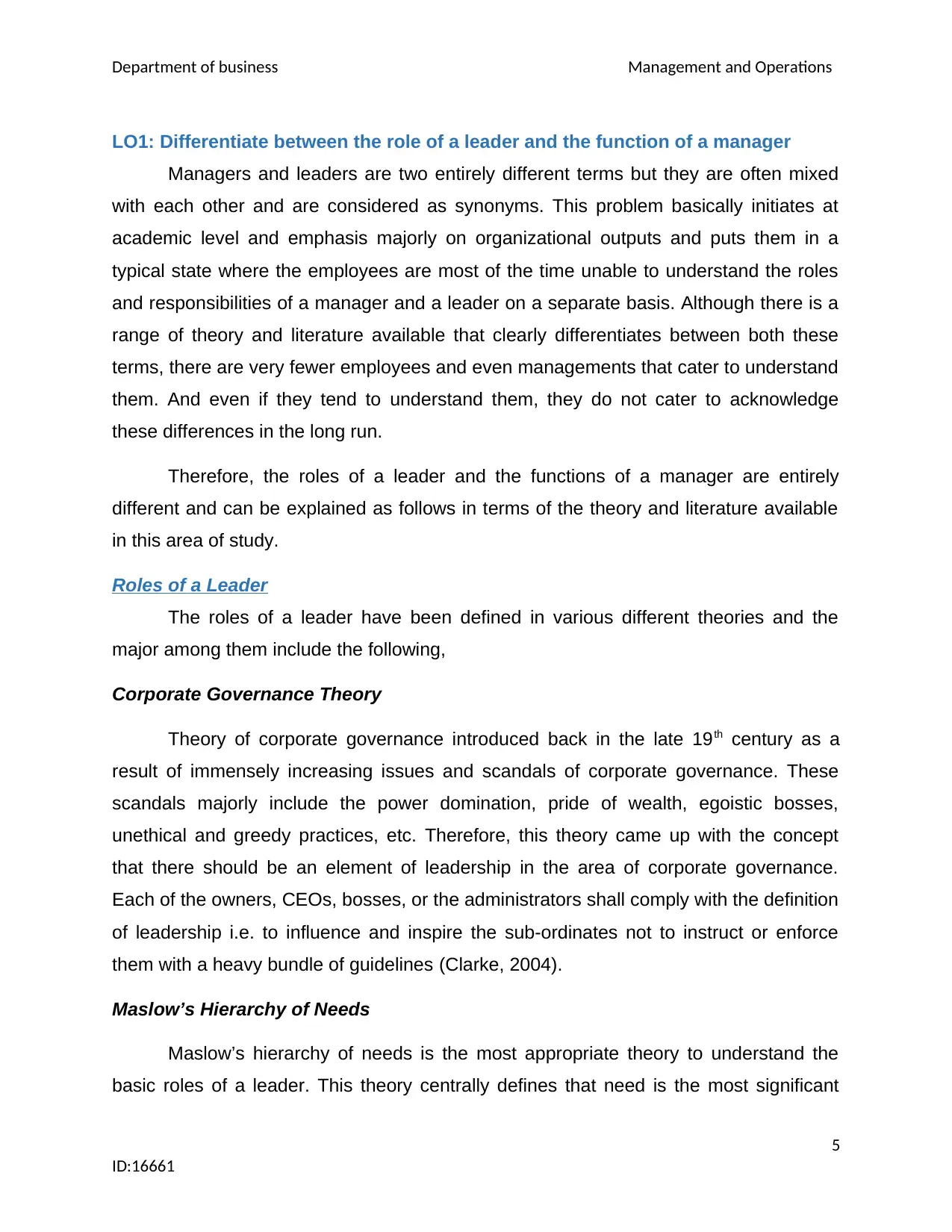
Department of business Management and Operations
LO1: Differentiate between the role of a leader and the function of a manager
Managers and leaders are two entirely different terms but they are often mixed
with each other and are considered as synonyms. This problem basically initiates at
academic level and emphasis majorly on organizational outputs and puts them in a
typical state where the employees are most of the time unable to understand the roles
and responsibilities of a manager and a leader on a separate basis. Although there is a
range of theory and literature available that clearly differentiates between both these
terms, there are very fewer employees and even managements that cater to understand
them. And even if they tend to understand them, they do not cater to acknowledge
these differences in the long run.
Therefore, the roles of a leader and the functions of a manager are entirely
different and can be explained as follows in terms of the theory and literature available
in this area of study.
Roles of a Leader
The roles of a leader have been defined in various different theories and the
major among them include the following,
Corporate Governance Theory
Theory of corporate governance introduced back in the late 19th century as a
result of immensely increasing issues and scandals of corporate governance. These
scandals majorly include the power domination, pride of wealth, egoistic bosses,
unethical and greedy practices, etc. Therefore, this theory came up with the concept
that there should be an element of leadership in the area of corporate governance.
Each of the owners, CEOs, bosses, or the administrators shall comply with the definition
of leadership i.e. to influence and inspire the sub-ordinates not to instruct or enforce
them with a heavy bundle of guidelines (Clarke, 2004).
Maslow’s Hierarchy of Needs
Maslow’s hierarchy of needs is the most appropriate theory to understand the
basic roles of a leader. This theory centrally defines that need is the most significant
5
ID:16661
LO1: Differentiate between the role of a leader and the function of a manager
Managers and leaders are two entirely different terms but they are often mixed
with each other and are considered as synonyms. This problem basically initiates at
academic level and emphasis majorly on organizational outputs and puts them in a
typical state where the employees are most of the time unable to understand the roles
and responsibilities of a manager and a leader on a separate basis. Although there is a
range of theory and literature available that clearly differentiates between both these
terms, there are very fewer employees and even managements that cater to understand
them. And even if they tend to understand them, they do not cater to acknowledge
these differences in the long run.
Therefore, the roles of a leader and the functions of a manager are entirely
different and can be explained as follows in terms of the theory and literature available
in this area of study.
Roles of a Leader
The roles of a leader have been defined in various different theories and the
major among them include the following,
Corporate Governance Theory
Theory of corporate governance introduced back in the late 19th century as a
result of immensely increasing issues and scandals of corporate governance. These
scandals majorly include the power domination, pride of wealth, egoistic bosses,
unethical and greedy practices, etc. Therefore, this theory came up with the concept
that there should be an element of leadership in the area of corporate governance.
Each of the owners, CEOs, bosses, or the administrators shall comply with the definition
of leadership i.e. to influence and inspire the sub-ordinates not to instruct or enforce
them with a heavy bundle of guidelines (Clarke, 2004).
Maslow’s Hierarchy of Needs
Maslow’s hierarchy of needs is the most appropriate theory to understand the
basic roles of a leader. This theory centrally defines that need is the most significant
5
ID:16661
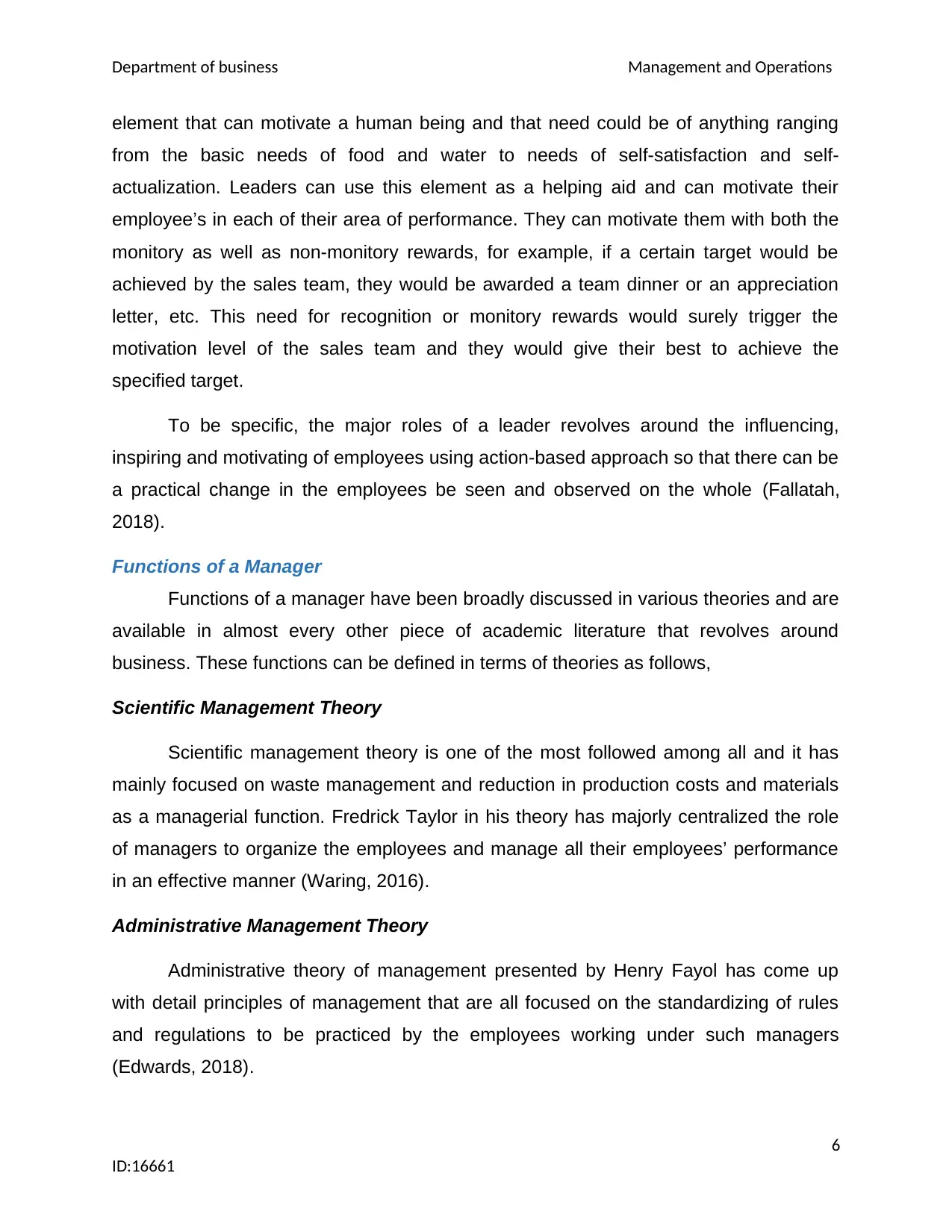
Department of business Management and Operations
element that can motivate a human being and that need could be of anything ranging
from the basic needs of food and water to needs of self-satisfaction and self-
actualization. Leaders can use this element as a helping aid and can motivate their
employee’s in each of their area of performance. They can motivate them with both the
monitory as well as non-monitory rewards, for example, if a certain target would be
achieved by the sales team, they would be awarded a team dinner or an appreciation
letter, etc. This need for recognition or monitory rewards would surely trigger the
motivation level of the sales team and they would give their best to achieve the
specified target.
To be specific, the major roles of a leader revolves around the influencing,
inspiring and motivating of employees using action-based approach so that there can be
a practical change in the employees be seen and observed on the whole (Fallatah,
2018).
Functions of a Manager
Functions of a manager have been broadly discussed in various theories and are
available in almost every other piece of academic literature that revolves around
business. These functions can be defined in terms of theories as follows,
Scientific Management Theory
Scientific management theory is one of the most followed among all and it has
mainly focused on waste management and reduction in production costs and materials
as a managerial function. Fredrick Taylor in his theory has majorly centralized the role
of managers to organize the employees and manage all their employees’ performance
in an effective manner (Waring, 2016).
Administrative Management Theory
Administrative theory of management presented by Henry Fayol has come up
with detail principles of management that are all focused on the standardizing of rules
and regulations to be practiced by the employees working under such managers
(Edwards, 2018).
6
ID:16661
element that can motivate a human being and that need could be of anything ranging
from the basic needs of food and water to needs of self-satisfaction and self-
actualization. Leaders can use this element as a helping aid and can motivate their
employee’s in each of their area of performance. They can motivate them with both the
monitory as well as non-monitory rewards, for example, if a certain target would be
achieved by the sales team, they would be awarded a team dinner or an appreciation
letter, etc. This need for recognition or monitory rewards would surely trigger the
motivation level of the sales team and they would give their best to achieve the
specified target.
To be specific, the major roles of a leader revolves around the influencing,
inspiring and motivating of employees using action-based approach so that there can be
a practical change in the employees be seen and observed on the whole (Fallatah,
2018).
Functions of a Manager
Functions of a manager have been broadly discussed in various theories and are
available in almost every other piece of academic literature that revolves around
business. These functions can be defined in terms of theories as follows,
Scientific Management Theory
Scientific management theory is one of the most followed among all and it has
mainly focused on waste management and reduction in production costs and materials
as a managerial function. Fredrick Taylor in his theory has majorly centralized the role
of managers to organize the employees and manage all their employees’ performance
in an effective manner (Waring, 2016).
Administrative Management Theory
Administrative theory of management presented by Henry Fayol has come up
with detail principles of management that are all focused on the standardizing of rules
and regulations to be practiced by the employees working under such managers
(Edwards, 2018).
6
ID:16661
⊘ This is a preview!⊘
Do you want full access?
Subscribe today to unlock all pages.

Trusted by 1+ million students worldwide
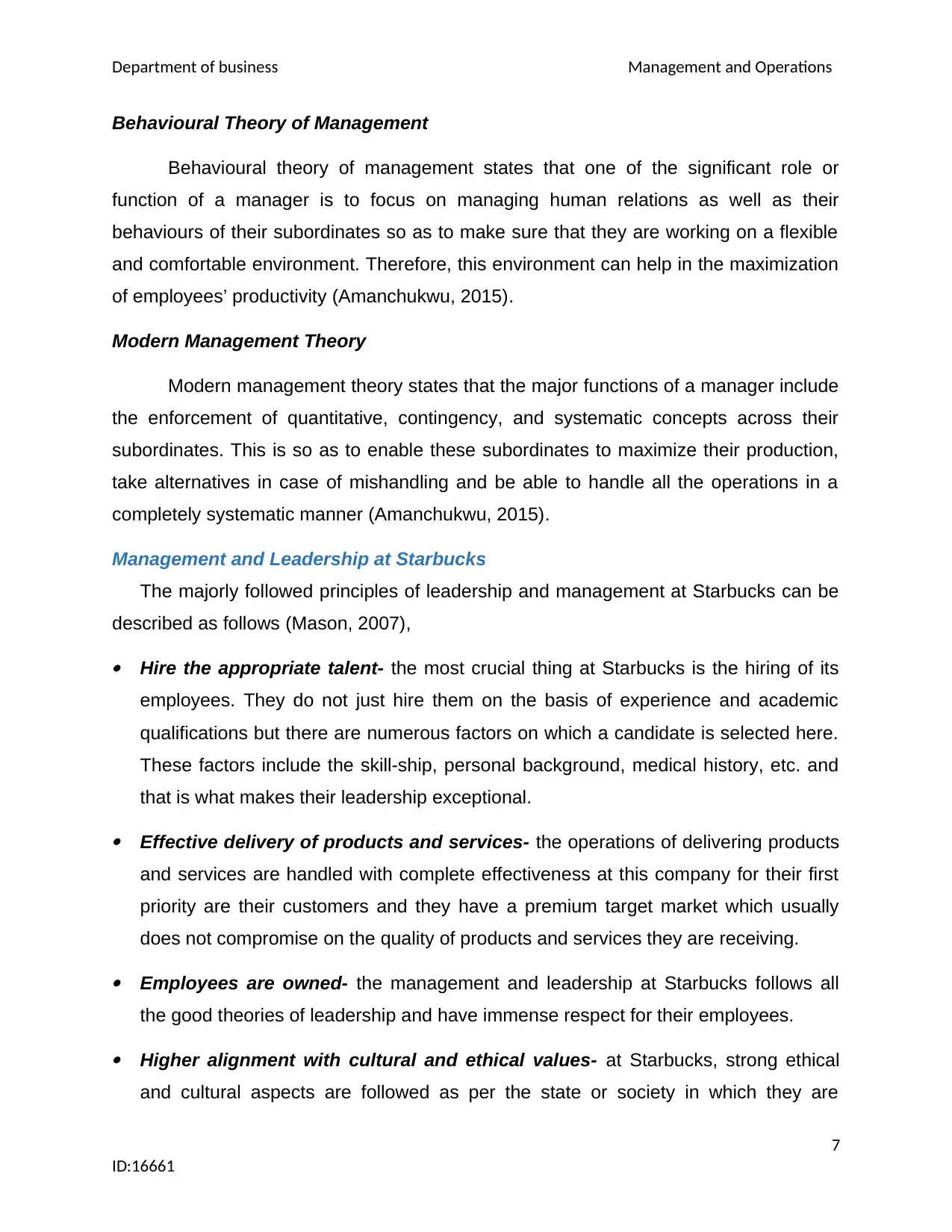
Department of business Management and Operations
Behavioural Theory of Management
Behavioural theory of management states that one of the significant role or
function of a manager is to focus on managing human relations as well as their
behaviours of their subordinates so as to make sure that they are working on a flexible
and comfortable environment. Therefore, this environment can help in the maximization
of employees’ productivity (Amanchukwu, 2015).
Modern Management Theory
Modern management theory states that the major functions of a manager include
the enforcement of quantitative, contingency, and systematic concepts across their
subordinates. This is so as to enable these subordinates to maximize their production,
take alternatives in case of mishandling and be able to handle all the operations in a
completely systematic manner (Amanchukwu, 2015).
Management and Leadership at Starbucks
The majorly followed principles of leadership and management at Starbucks can be
described as follows (Mason, 2007),
Hire the appropriate talent- the most crucial thing at Starbucks is the hiring of its
employees. They do not just hire them on the basis of experience and academic
qualifications but there are numerous factors on which a candidate is selected here.
These factors include the skill-ship, personal background, medical history, etc. and
that is what makes their leadership exceptional.
Effective delivery of products and services- the operations of delivering products
and services are handled with complete effectiveness at this company for their first
priority are their customers and they have a premium target market which usually
does not compromise on the quality of products and services they are receiving.
Employees are owned- the management and leadership at Starbucks follows all
the good theories of leadership and have immense respect for their employees.
Higher alignment with cultural and ethical values- at Starbucks, strong ethical
and cultural aspects are followed as per the state or society in which they are
7
ID:16661
Behavioural Theory of Management
Behavioural theory of management states that one of the significant role or
function of a manager is to focus on managing human relations as well as their
behaviours of their subordinates so as to make sure that they are working on a flexible
and comfortable environment. Therefore, this environment can help in the maximization
of employees’ productivity (Amanchukwu, 2015).
Modern Management Theory
Modern management theory states that the major functions of a manager include
the enforcement of quantitative, contingency, and systematic concepts across their
subordinates. This is so as to enable these subordinates to maximize their production,
take alternatives in case of mishandling and be able to handle all the operations in a
completely systematic manner (Amanchukwu, 2015).
Management and Leadership at Starbucks
The majorly followed principles of leadership and management at Starbucks can be
described as follows (Mason, 2007),
Hire the appropriate talent- the most crucial thing at Starbucks is the hiring of its
employees. They do not just hire them on the basis of experience and academic
qualifications but there are numerous factors on which a candidate is selected here.
These factors include the skill-ship, personal background, medical history, etc. and
that is what makes their leadership exceptional.
Effective delivery of products and services- the operations of delivering products
and services are handled with complete effectiveness at this company for their first
priority are their customers and they have a premium target market which usually
does not compromise on the quality of products and services they are receiving.
Employees are owned- the management and leadership at Starbucks follows all
the good theories of leadership and have immense respect for their employees.
Higher alignment with cultural and ethical values- at Starbucks, strong ethical
and cultural aspects are followed as per the state or society in which they are
7
ID:16661
Paraphrase This Document
Need a fresh take? Get an instant paraphrase of this document with our AI Paraphraser
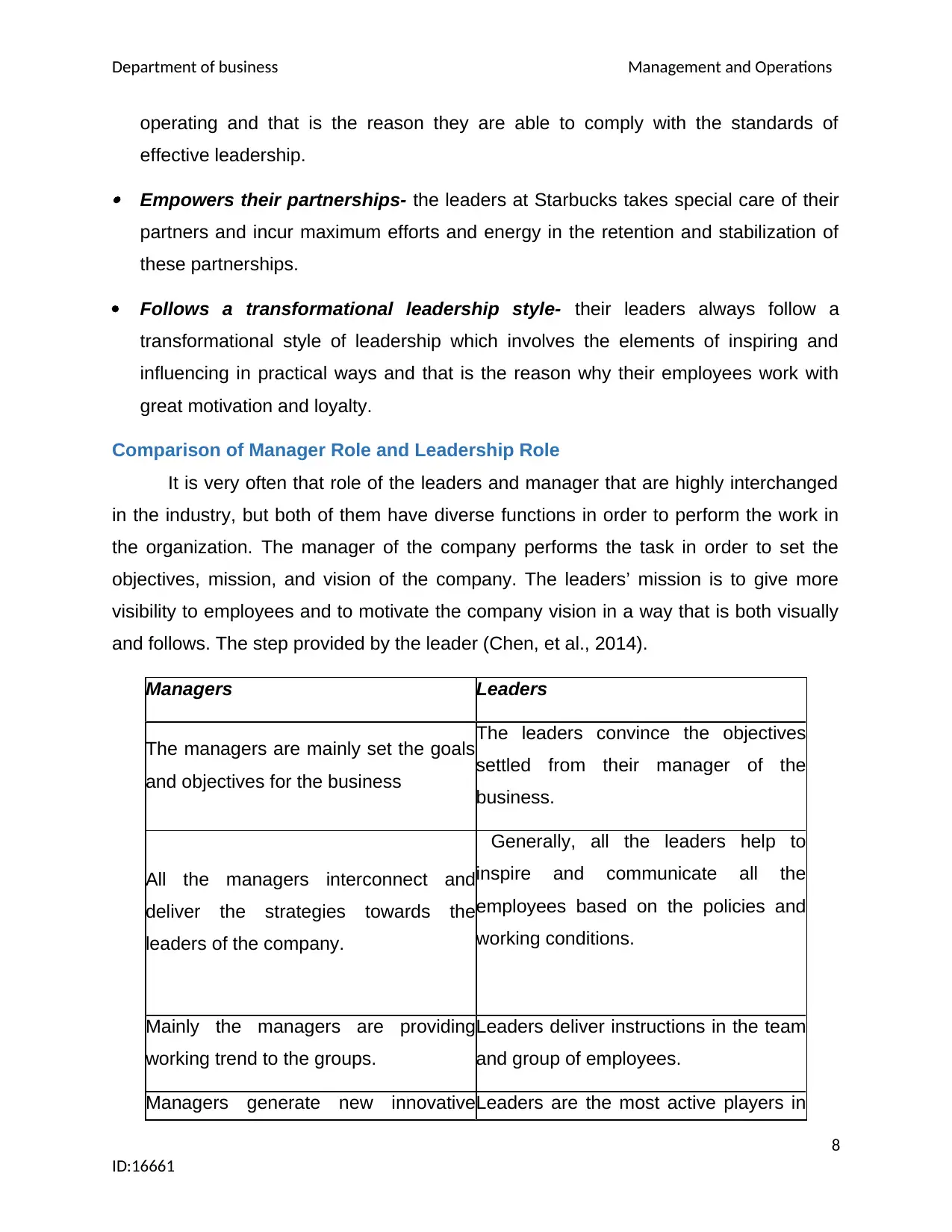
Department of business Management and Operations
operating and that is the reason they are able to comply with the standards of
effective leadership.
Empowers their partnerships- the leaders at Starbucks takes special care of their
partners and incur maximum efforts and energy in the retention and stabilization of
these partnerships.
Follows a transformational leadership style- their leaders always follow a
transformational style of leadership which involves the elements of inspiring and
influencing in practical ways and that is the reason why their employees work with
great motivation and loyalty.
Comparison of Manager Role and Leadership Role
It is very often that role of the leaders and manager that are highly interchanged
in the industry, but both of them have diverse functions in order to perform the work in
the organization. The manager of the company performs the task in order to set the
objectives, mission, and vision of the company. The leaders’ mission is to give more
visibility to employees and to motivate the company vision in a way that is both visually
and follows. The step provided by the leader (Chen, et al., 2014).
Managers Leaders
The managers are mainly set the goals
and objectives for the business
The leaders convince the objectives
settled from their manager of the
business.
All the managers interconnect and
deliver the strategies towards the
leaders of the company.
Generally, all the leaders help to
inspire and communicate all the
employees based on the policies and
working conditions.
Mainly the managers are providing
working trend to the groups.
Leaders deliver instructions in the team
and group of employees.
Managers generate new innovativeLeaders are the most active players in
8
ID:16661
operating and that is the reason they are able to comply with the standards of
effective leadership.
Empowers their partnerships- the leaders at Starbucks takes special care of their
partners and incur maximum efforts and energy in the retention and stabilization of
these partnerships.
Follows a transformational leadership style- their leaders always follow a
transformational style of leadership which involves the elements of inspiring and
influencing in practical ways and that is the reason why their employees work with
great motivation and loyalty.
Comparison of Manager Role and Leadership Role
It is very often that role of the leaders and manager that are highly interchanged
in the industry, but both of them have diverse functions in order to perform the work in
the organization. The manager of the company performs the task in order to set the
objectives, mission, and vision of the company. The leaders’ mission is to give more
visibility to employees and to motivate the company vision in a way that is both visually
and follows. The step provided by the leader (Chen, et al., 2014).
Managers Leaders
The managers are mainly set the goals
and objectives for the business
The leaders convince the objectives
settled from their manager of the
business.
All the managers interconnect and
deliver the strategies towards the
leaders of the company.
Generally, all the leaders help to
inspire and communicate all the
employees based on the policies and
working conditions.
Mainly the managers are providing
working trend to the groups.
Leaders deliver instructions in the team
and group of employees.
Managers generate new innovativeLeaders are the most active players in
8
ID:16661
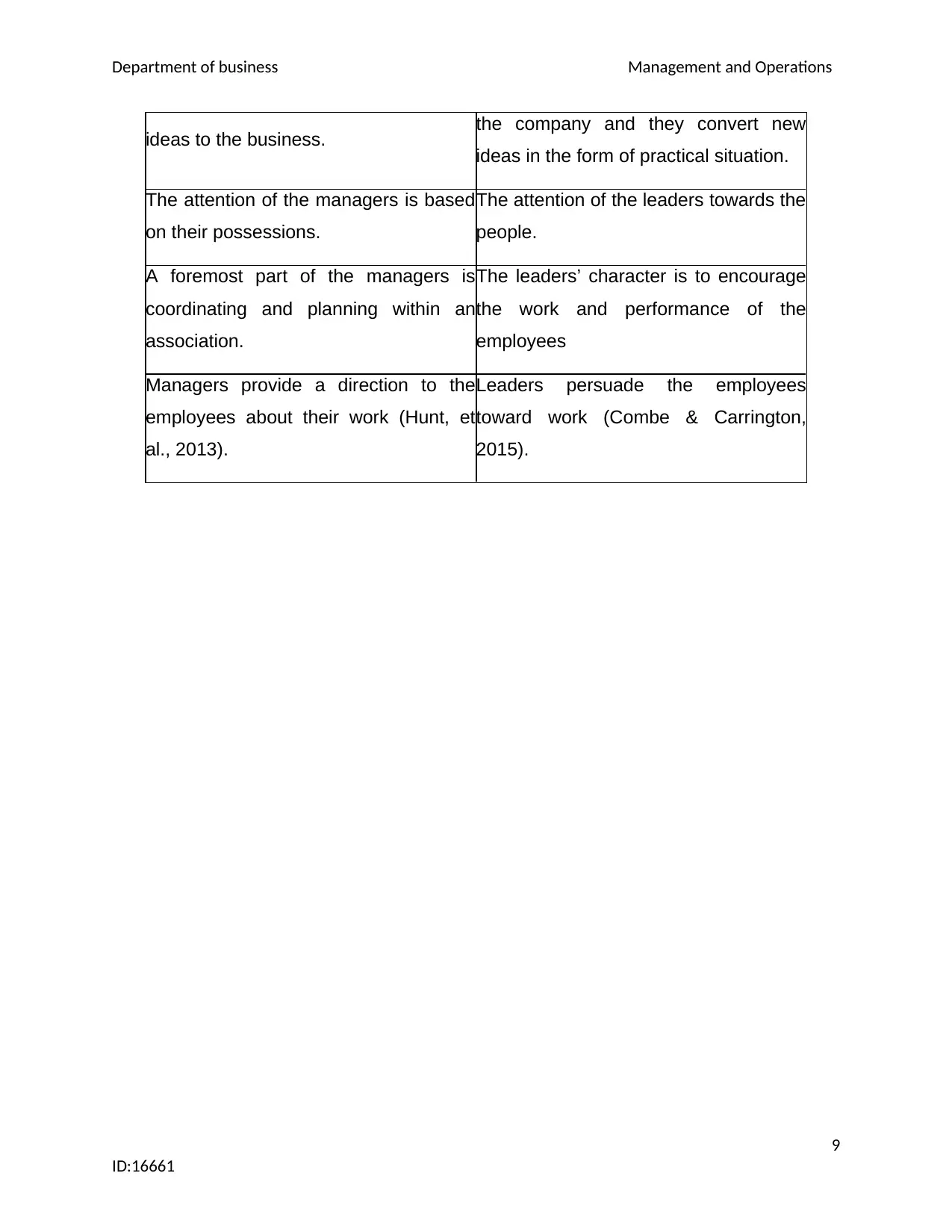
Department of business Management and Operations
ideas to the business. the company and they convert new
ideas in the form of practical situation.
The attention of the managers is based
on their possessions.
The attention of the leaders towards the
people.
A foremost part of the managers is
coordinating and planning within an
association.
The leaders’ character is to encourage
the work and performance of the
employees
Managers provide a direction to the
employees about their work (Hunt, et
al., 2013).
Leaders persuade the employees
toward work (Combe & Carrington,
2015).
9
ID:16661
ideas to the business. the company and they convert new
ideas in the form of practical situation.
The attention of the managers is based
on their possessions.
The attention of the leaders towards the
people.
A foremost part of the managers is
coordinating and planning within an
association.
The leaders’ character is to encourage
the work and performance of the
employees
Managers provide a direction to the
employees about their work (Hunt, et
al., 2013).
Leaders persuade the employees
toward work (Combe & Carrington,
2015).
9
ID:16661
⊘ This is a preview!⊘
Do you want full access?
Subscribe today to unlock all pages.

Trusted by 1+ million students worldwide
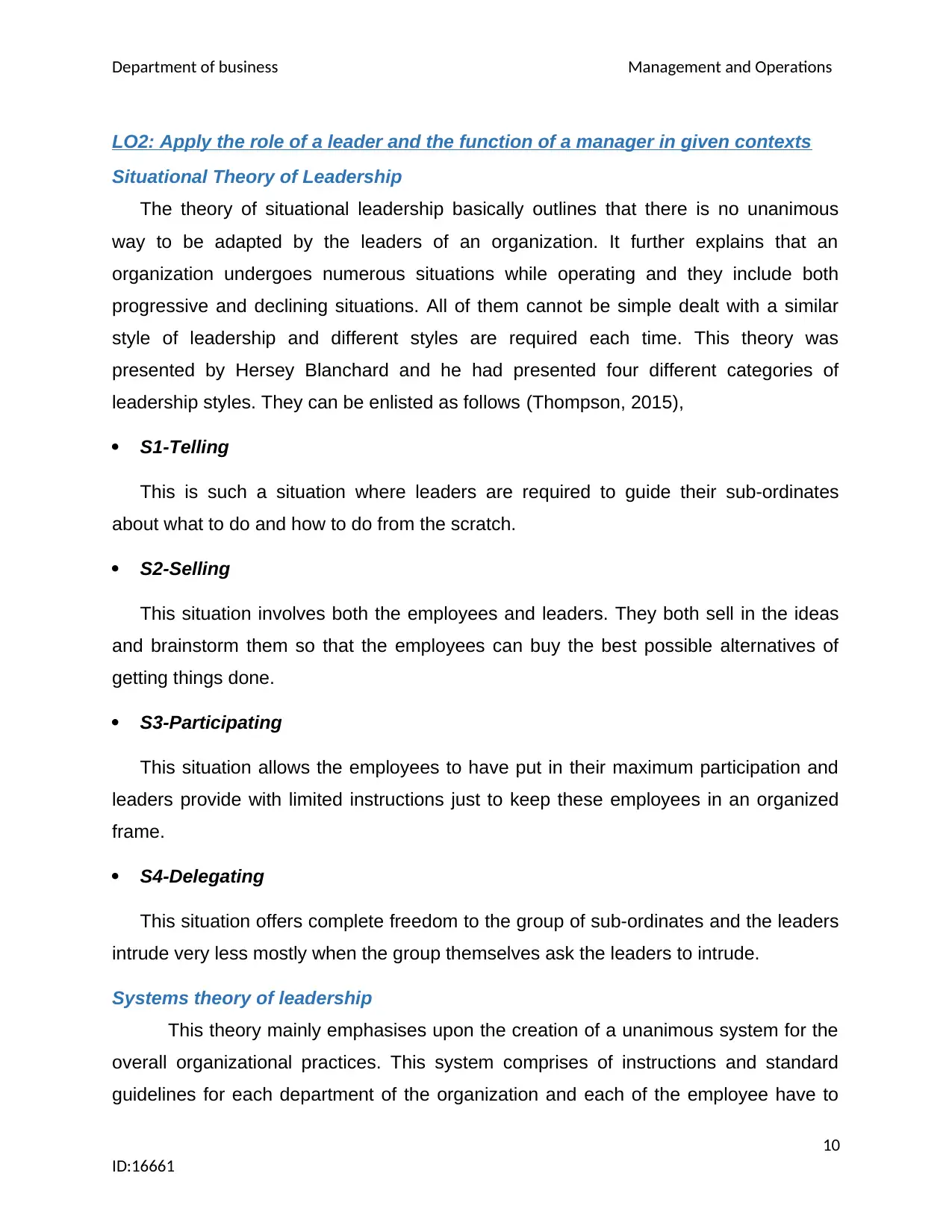
Department of business Management and Operations
LO2: Apply the role of a leader and the function of a manager in given contexts
Situational Theory of Leadership
The theory of situational leadership basically outlines that there is no unanimous
way to be adapted by the leaders of an organization. It further explains that an
organization undergoes numerous situations while operating and they include both
progressive and declining situations. All of them cannot be simple dealt with a similar
style of leadership and different styles are required each time. This theory was
presented by Hersey Blanchard and he had presented four different categories of
leadership styles. They can be enlisted as follows (Thompson, 2015),
S1-Telling
This is such a situation where leaders are required to guide their sub-ordinates
about what to do and how to do from the scratch.
S2-Selling
This situation involves both the employees and leaders. They both sell in the ideas
and brainstorm them so that the employees can buy the best possible alternatives of
getting things done.
S3-Participating
This situation allows the employees to have put in their maximum participation and
leaders provide with limited instructions just to keep these employees in an organized
frame.
S4-Delegating
This situation offers complete freedom to the group of sub-ordinates and the leaders
intrude very less mostly when the group themselves ask the leaders to intrude.
Systems theory of leadership
This theory mainly emphasises upon the creation of a unanimous system for the
overall organizational practices. This system comprises of instructions and standard
guidelines for each department of the organization and each of the employee have to
10
ID:16661
LO2: Apply the role of a leader and the function of a manager in given contexts
Situational Theory of Leadership
The theory of situational leadership basically outlines that there is no unanimous
way to be adapted by the leaders of an organization. It further explains that an
organization undergoes numerous situations while operating and they include both
progressive and declining situations. All of them cannot be simple dealt with a similar
style of leadership and different styles are required each time. This theory was
presented by Hersey Blanchard and he had presented four different categories of
leadership styles. They can be enlisted as follows (Thompson, 2015),
S1-Telling
This is such a situation where leaders are required to guide their sub-ordinates
about what to do and how to do from the scratch.
S2-Selling
This situation involves both the employees and leaders. They both sell in the ideas
and brainstorm them so that the employees can buy the best possible alternatives of
getting things done.
S3-Participating
This situation allows the employees to have put in their maximum participation and
leaders provide with limited instructions just to keep these employees in an organized
frame.
S4-Delegating
This situation offers complete freedom to the group of sub-ordinates and the leaders
intrude very less mostly when the group themselves ask the leaders to intrude.
Systems theory of leadership
This theory mainly emphasises upon the creation of a unanimous system for the
overall organizational practices. This system comprises of instructions and standard
guidelines for each department of the organization and each of the employee have to
10
ID:16661
Paraphrase This Document
Need a fresh take? Get an instant paraphrase of this document with our AI Paraphraser
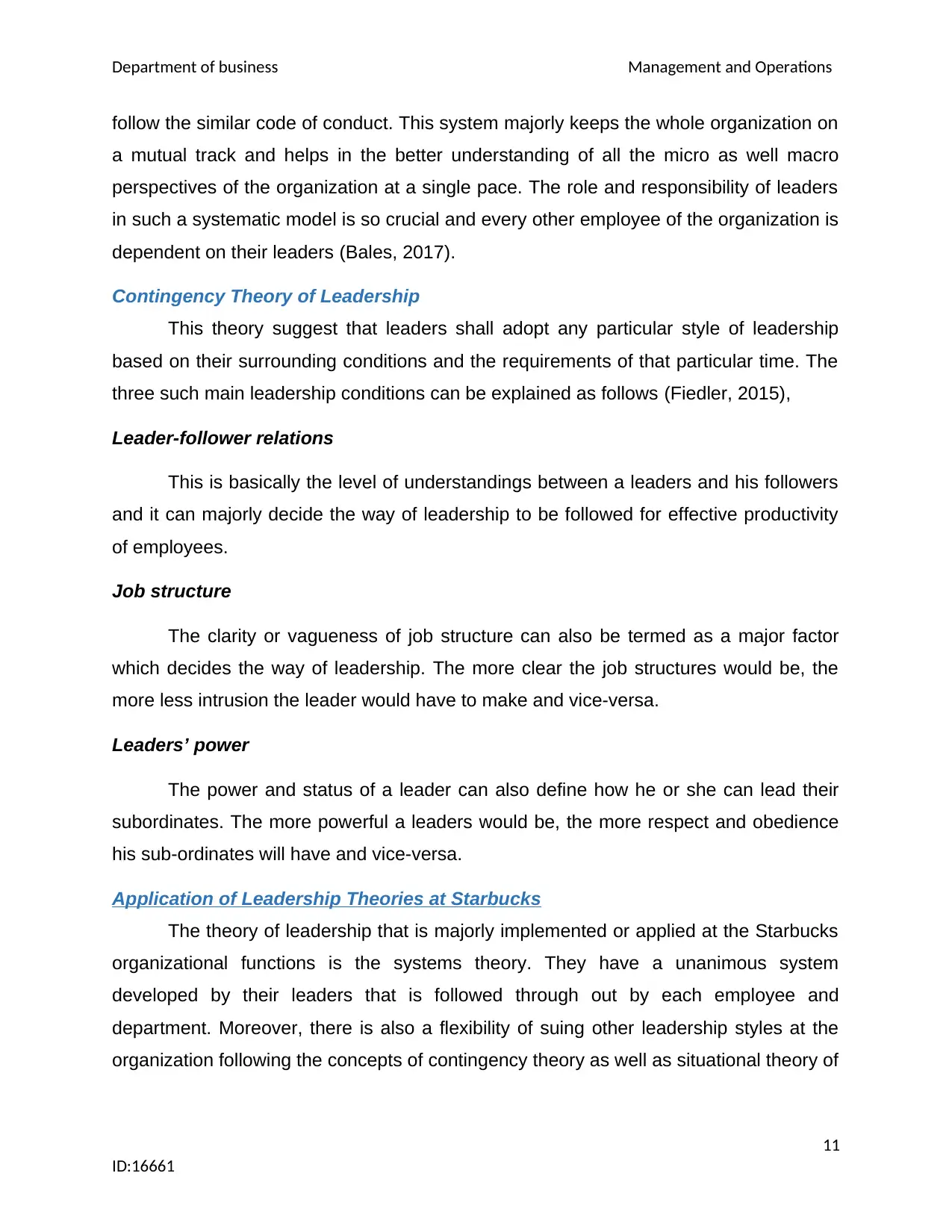
Department of business Management and Operations
follow the similar code of conduct. This system majorly keeps the whole organization on
a mutual track and helps in the better understanding of all the micro as well macro
perspectives of the organization at a single pace. The role and responsibility of leaders
in such a systematic model is so crucial and every other employee of the organization is
dependent on their leaders (Bales, 2017).
Contingency Theory of Leadership
This theory suggest that leaders shall adopt any particular style of leadership
based on their surrounding conditions and the requirements of that particular time. The
three such main leadership conditions can be explained as follows (Fiedler, 2015),
Leader-follower relations
This is basically the level of understandings between a leaders and his followers
and it can majorly decide the way of leadership to be followed for effective productivity
of employees.
Job structure
The clarity or vagueness of job structure can also be termed as a major factor
which decides the way of leadership. The more clear the job structures would be, the
more less intrusion the leader would have to make and vice-versa.
Leaders’ power
The power and status of a leader can also define how he or she can lead their
subordinates. The more powerful a leaders would be, the more respect and obedience
his sub-ordinates will have and vice-versa.
Application of Leadership Theories at Starbucks
The theory of leadership that is majorly implemented or applied at the Starbucks
organizational functions is the systems theory. They have a unanimous system
developed by their leaders that is followed through out by each employee and
department. Moreover, there is also a flexibility of suing other leadership styles at the
organization following the concepts of contingency theory as well as situational theory of
11
ID:16661
follow the similar code of conduct. This system majorly keeps the whole organization on
a mutual track and helps in the better understanding of all the micro as well macro
perspectives of the organization at a single pace. The role and responsibility of leaders
in such a systematic model is so crucial and every other employee of the organization is
dependent on their leaders (Bales, 2017).
Contingency Theory of Leadership
This theory suggest that leaders shall adopt any particular style of leadership
based on their surrounding conditions and the requirements of that particular time. The
three such main leadership conditions can be explained as follows (Fiedler, 2015),
Leader-follower relations
This is basically the level of understandings between a leaders and his followers
and it can majorly decide the way of leadership to be followed for effective productivity
of employees.
Job structure
The clarity or vagueness of job structure can also be termed as a major factor
which decides the way of leadership. The more clear the job structures would be, the
more less intrusion the leader would have to make and vice-versa.
Leaders’ power
The power and status of a leader can also define how he or she can lead their
subordinates. The more powerful a leaders would be, the more respect and obedience
his sub-ordinates will have and vice-versa.
Application of Leadership Theories at Starbucks
The theory of leadership that is majorly implemented or applied at the Starbucks
organizational functions is the systems theory. They have a unanimous system
developed by their leaders that is followed through out by each employee and
department. Moreover, there is also a flexibility of suing other leadership styles at the
organization following the concepts of contingency theory as well as situational theory of
11
ID:16661
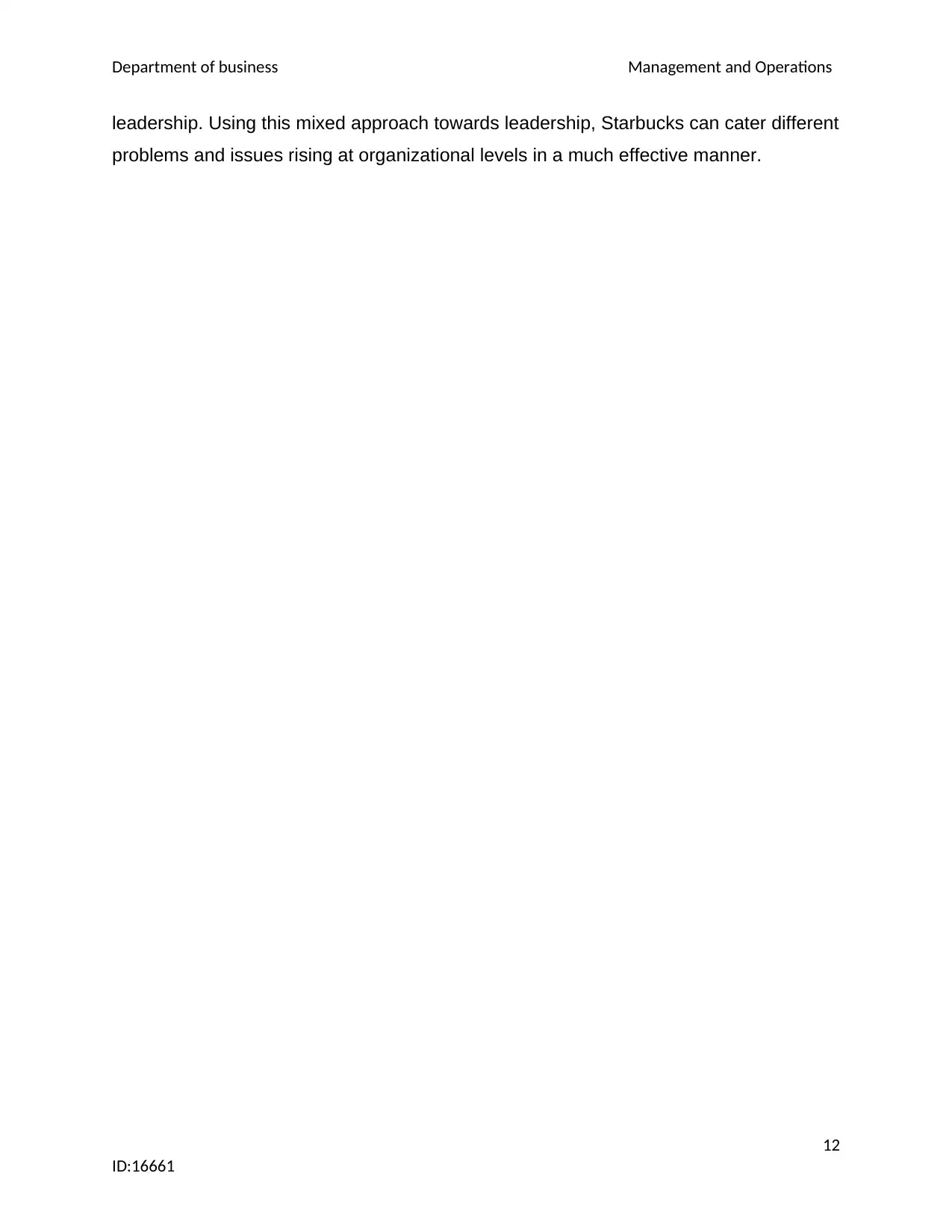
Department of business Management and Operations
leadership. Using this mixed approach towards leadership, Starbucks can cater different
problems and issues rising at organizational levels in a much effective manner.
12
ID:16661
leadership. Using this mixed approach towards leadership, Starbucks can cater different
problems and issues rising at organizational levels in a much effective manner.
12
ID:16661
⊘ This is a preview!⊘
Do you want full access?
Subscribe today to unlock all pages.

Trusted by 1+ million students worldwide
1 out of 20
Related Documents
Your All-in-One AI-Powered Toolkit for Academic Success.
+13062052269
info@desklib.com
Available 24*7 on WhatsApp / Email
![[object Object]](/_next/static/media/star-bottom.7253800d.svg)
Unlock your academic potential
Copyright © 2020–2025 A2Z Services. All Rights Reserved. Developed and managed by ZUCOL.



